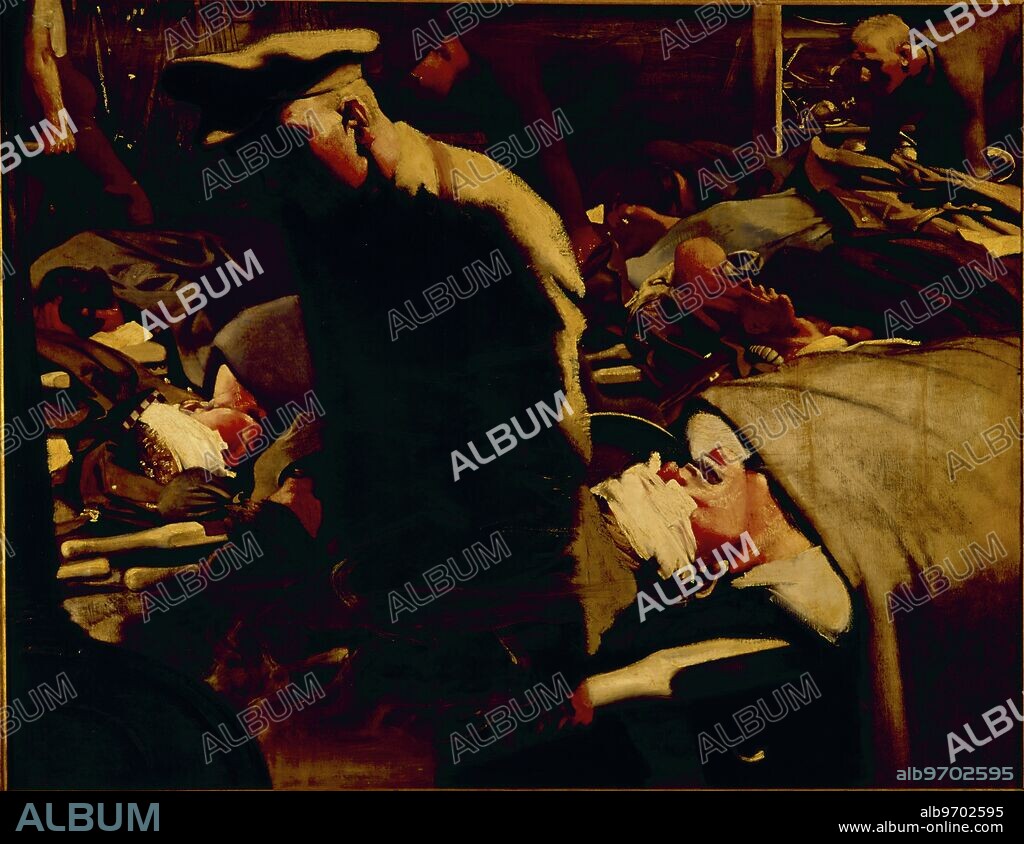alb9702595
Eric Kennington, Gassed and Wounded, 1918, oil on canvas, 71.1 x 91.4 cm, Imperial War Museum, London.. . Eric Kennington, the son of the painter Thomas Kennington, was born in Chelsea in 1888. His father was a portrait painter and an active member of the New English Art Club. Educated at St. Paul's School and the Lambeth School of Art, Kennington first exhibited at the Royal Academy in 1908. . . On the outbreak of the First World War Kennington enlisted with the 13th London Regiment. He fought on the Western Front but was badly wounded and and sent home in June 1915. During his convalescence he produced The Kensingtons at Laventie, a portrait of a group of infantrymen. When exhibited in the spring of 1916 its portrayal of exhausted soldiers created a sensation.. . Following the success of the painting The Kensingtons at Laventrie, Kennington returned to France in August 1917, this time as a painter and not as an infantryman. He took his subjects from the daily life of the British troops, with always the same desire for truth, be it as painful as that revealed by this painting. This is a tightly-knit work, there is a sharp contrast between light and dark, and the postures of the bodies piled up in a narrow space are disturbing. Such immediacy and simplicity makes it the most painfully effective treatment of this subject by a painter.. . ©TopFoto

|
Ajouter à une autre Lightbox |
|
Ajouter à une autre Lightbox |



Avez-vous déjà un compte? S'identifier
Vous n'avez pas de compte ? S'inscrire
Acheter cette image

Titre:
Eric Kennington, Gassed and Wounded, 1918, oil on canvas, 71.1 x 91.4 cm, Imperial War Museum, London.. . Eric Kennington, the son of the painter Thomas Kennington, was born in Chelsea in 1888. His father was a portrait painter and an active member of the New English Art Club. Educated at St. Paul's School and the Lambeth School of Art, Kennington first exhibited at the Royal Academy in 1908. . . On the outbreak of the First World War Kennington enlisted with the 13th London Regiment. He fought on the Western Front but was badly wounded and and sent home in June 1915. During his convalescence he produced The Kensingtons at Laventie, a portrait of a group of infantrymen. When exhibited in the spring of 1916 its portrayal of exhausted soldiers created a sensation.. . Following the success of the painting The Kensingtons at Laventrie, Kennington returned to France in August 1917, this time as a painter and not as an infantryman. He took his subjects from the daily life of the British troops, with always the same desire for truth, be it as painful as that revealed by this painting. This is a tightly-knit work, there is a sharp contrast between light and dark, and the postures of the bodies piled up in a narrow space are disturbing. Such immediacy and simplicity makes it the most painfully effective treatment of this subject by a painter.. . ©TopFoto
Légende:
Voir la traduction automatique
Eric Kennington, Gassed and Wounded, 1918, oil on canvas, 71.1 x 91.4 cm, Imperial War Museum, London.. Eric Kennington, the son of the painter Thomas Kennington, was born in Chelsea in 1888. His father was a portrait painter and an active member of the New English Art Club. Educated at St. Paul's School and the Lambeth School of Art, Kennington first exhibited at the Royal Academy in 1908. On the outbreak of the First World War Kennington enlisted with the 13th London Regiment. He fought on the Western Front but was badly wounded and and sent home in June 1915. During his convalescence he produced The Kensingtons at Laventie, a portrait of a group of infantrymen. When exhibited in the spring of 1916 its portrayal of exhausted soldiers created a sensation.. Following the success of the painting The Kensingtons at Laventrie, Kennington returned to France in August 1917, this time as a painter and not as an infantryman. He took his subjects from the daily life of the British troops, with always the same desire for truth, be it as painful as that revealed by this painting. This is a tightly-knit work, there is a sharp contrast between light and dark, and the postures of the bodies piled up in a narrow space are disturbing. Such immediacy and simplicity makes it the most painfully effective treatment of this subject by a painter.. ©TopFoto
Crédit:
Album / Christopher Barker / TopFoto
Autorisations:
Modèle: Non - Propriété: Non
Questions sur les droits?
Questions sur les droits?
Taille de l'image:
5002 x 3862 px | 55.3 MB
Taille d'impression:
42.4 x 32.7 cm | 16.7 x 12.9 in (300 dpi)
Mots clés:
 Pinterest
Pinterest Twitter
Twitter Facebook
Facebook Copier le lien
Copier le lien Email
Email
